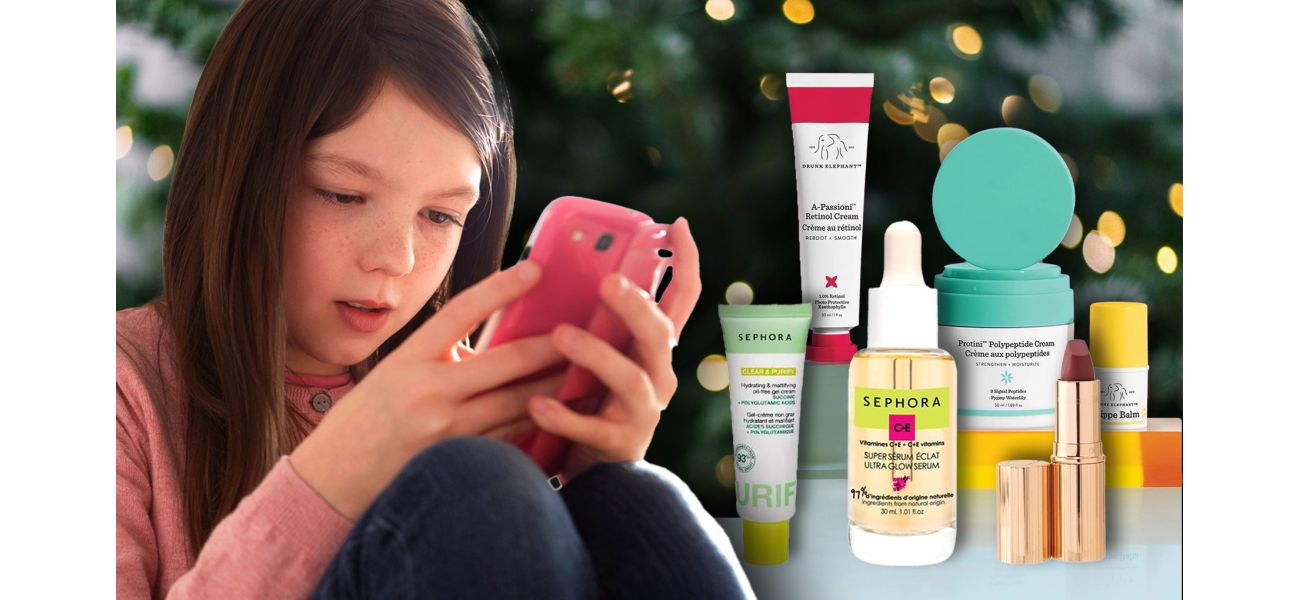Children are asking Santa for expensive beauty items that total hundreds of of pounds.
In the past, tweens were content with a dewberry gift set from The Body Shop, but now things have changed.
December 14th 2024.

"Back in the day, a simple dewberry gift set from The Body Shop would have been enough to make any tween's day. But times have definitely changed. As Jo Emerson glanced over the Christmas list her daughters had given her, she couldn't help but notice the high-end beauty brands they were asking for. Charlotte Tilbury, Azio Beauty, MAC... each one with a hefty price tag. Her daughters, who have been buying beauty products since the age of 13, had expensive tastes. But it was Christmas, so Jo couldn't blame them for dreaming big.
December is the busiest time for holiday shopping, and young girls can be seen flocking to makeup counters at Sephora or filling their online baskets with Drunk Elephant and Rare Beauty. They are determined to build makeup collections that rival their mothers'. Jo, a mother of three teenage daughters, has seen firsthand the impact of social media on her girls' beauty routines. They already have an array of moisturizers, primers, setting sprays, and other skincare staples in their collection. On average, they spend £30-50 a month on beauty products, with moisturizers and primers being the most expensive items. "One of my girls recently spent £20 on a setting spray, which I didn't even know was a thing," Jo laughs. "And another paid £15 for a moisturizer. As a mom on a tight budget, it's hard to fathom spending that much on beauty products."
Gone are the days of being content with a simple gift set. Today's young girls, known as "Sephora Tweens" online, are already experts in makeup techniques popularized by celebrities like the Kardashians. They are immersed in the world of beauty, thanks to social media platforms like TikTok and Instagram. The viral hashtag #sephoratweens has become a staple on TikTok, often accompanied by videos of young girls flooding makeup stores and snatching up the latest must-have products. Unfortunately, this trend has also led to some concerning behavior, such as being rude to store staff and destroying product testers.
Jo is not the only parent concerned about the impact of social media on their children's perception of beauty. A TikTok video by mom @staarcosmic, in which she talks about the toxic influence of beauty influencers on young girls, has been viewed over 300,000 times. Retail insiders have also noticed a rise in demand for beauty products among tweens, making it clear that this demographic is a lucrative market for the beauty industry. Brand expert Rachel Humphrey explains, "What started out as a niche trend has become a reality in the retail landscape. Luxury brands are seeing a shift in young shoppers, and tween-focused premium brands are booming."
By day, Jo works as an executive coach, helping leaders and teams build confidence and perform at their best. She tries to instill the same principles in her daughters, but she worries about the external pressures they face, especially in regards to their appearance. "My generation worked hard to break the objectification of women, and yet here are my daughters worrying about how they look," Jo laments. She is frustrated by the amount of time and money her daughters spend on beauty products, which she deems "extreme." "I can barely be bothered to wash my face with soap and use a dab of Nivea, and my daughters have elaborate routines. It's mind-boggling."
Despite her concerns, Jo is relieved that her daughters are comfortable going bare-faced in front of their close friends and family. It's online or at school where they feel the most judged. Jo has always taught her daughters that "less is more" when it comes to makeup, but she knows that social media often portrays a different narrative. "They see these images of 'perfect skin' online, and that's the standard they have in their minds. But if these messages become more dominant, we'll have an epidemic of facial dysmorphia, where young people see imperfections that aren't there." Sadly, Jo's concerns are not unfounded, as numerous studies have shown the negative impact of social media on young girls' self-esteem and body image.
The Girlguiding Girls' Attitudes Survey found that many young girls in the UK struggle with negative thoughts about their appearance, which greatly affects their confidence. As we approach Christmas, it's important to remember that the pressure to look a certain way is not just limited to adults. Young girls are also feeling the weight of societal expectations, amplified by social media. In this age of digital influence, it's crucial for parents to have open and honest conversations with their children about self-love and self-acceptance.
As Jo Emerson sat down to go through her daughters' Christmas lists, she couldn't help but feel a bit overwhelmed. Gone were the days when a simple dewberry gift set from The Body Shop would suffice for their stocking. Instead, she was faced with requests for luxury beauty products from Charlotte Tilbury, Azio Beauty, and MAC, all with hefty price tags.
Her three teenage daughters had been buying beauty products since they were 13, and their lists reflected their expertise in the world of makeup. Jo knew that these were ambitious asks that went far beyond their everyday budgets, but it was Christmas after all, and she wanted to make their wishes come true.
With December being the peak time for holiday shopping, Jo had noticed a change in her daughters' shopping habits. They were now crowding around makeup counters at Sephora and Space NK, as well as filling their online baskets with high-end brands like Drunk Elephant and Rare Beauty. It seemed they were determined to build makeup hauls that could rival their mothers'.
Jo shared with Metro that her daughters' beauty routines already included a mix of moisturizers, primers, setting sprays, and other skincare staples. On average, they were spending £30-50 a month on beauty products, with moisturizers and primers being the most expensive items. She couldn't believe it when one of her girls had recently spent £20 on a setting spray, and another had paid £15 for a moisturizer. These were prices that, as a mother on a tight budget, she found unfathomable.
It was clear that times had changed since Jo's own teenage years, when a dewberry set was all she needed. Nowadays, young girls, known online as "Sephora Tweens," were already experts in makeup techniques like contouring and filling in brows, thanks to the influence of beauty influencers like the Kardashians.
The crowds at the grand opening of a new Sephora store in Westfield Stratford were a testament to this trend. The viral hashtag #sephoratweens had become popular on TikTok, with videos of young girls flooding stores like Sephora and Ulta Beauty in search of the latest makeup must-haves. Unfortunately, this trend had also brought some negative consequences, with clips surfacing of kids being rude to staff and destroying testers in the process.
In one TikTok video, viewed over 300,000 times with the hashtag #sephorakidsneedtobestopped, a concerned mother spoke out about the toxic impact of beauty influencers on her nine-year-old daughter. It was clear that social media was playing a significant role in driving the obsession with beauty among young girls.
As Christmas approached, retail insiders had also noticed a rise in demand for beauty products from tweens. Brand expert Rachel Humphrey explained that luxury brands were seeing a significant shift in young shoppers and parents purchasing for them. She shared that tween-focused premium brands like Bubble had seen a staggering 900% increase in sales from 2022 to 2023.
Rachel, who was also a mother to eight-year-old Penelope, added that some brands naturally appealed to a younger audience due to their fun and playful branding. She also noted that product development was now leaning towards tweens, with the introduction of light fragrances, clear lip gloss ranges, and other wearable products.
By day, Jo Emerson worked as an international executive coach, helping leaders and teams build confidence and perform at their best. It was no surprise that these principles also trickled down into her conversations with her daughters. She believed that instilling self-belief and high self-esteem in her girls was crucial, especially in a world where external factors like social media could have a negative impact.
Jo was frustrated that her generation had worked so hard to break the objectification of women and girls, yet her daughters were still worried about their looks. She couldn't understand why they spent so much time and money on beauty products, deeming their routines extreme compared to her simple skincare routine.
One of Jo's biggest frustrations was when she would take a family photo, and her daughters would scrutinize it to make sure it was "postable" before she could share it online. However, she was relieved that they were still happy to go bare-faced when with their close friends and family. It was online or at school where they felt most judged, which concerned Jo.
She believed that social media's obsession with beauty was fueling her daughters' worries about their looks. The beauty community was one of the most popular globally on platforms like TikTok, YouTube, and Instagram, with millions of entries under the beauty hashtag. With negative thoughts about their appearance overwhelming many young girls in the UK, it was no surprise that Jo was worried about the impact on her daughters.
She feared that if these messages became more dominant, there would be an epidemic of facial dysmorphia, with young people seeing imperfections that weren't there. This concern was not unfounded, as numerous studies have highlighted the negative impact of social media on young girls' self-esteem and body image issues. It was a worrying trend that Jo hoped would change in the future.
December is the busiest time for holiday shopping, and young girls can be seen flocking to makeup counters at Sephora or filling their online baskets with Drunk Elephant and Rare Beauty. They are determined to build makeup collections that rival their mothers'. Jo, a mother of three teenage daughters, has seen firsthand the impact of social media on her girls' beauty routines. They already have an array of moisturizers, primers, setting sprays, and other skincare staples in their collection. On average, they spend £30-50 a month on beauty products, with moisturizers and primers being the most expensive items. "One of my girls recently spent £20 on a setting spray, which I didn't even know was a thing," Jo laughs. "And another paid £15 for a moisturizer. As a mom on a tight budget, it's hard to fathom spending that much on beauty products."
Gone are the days of being content with a simple gift set. Today's young girls, known as "Sephora Tweens" online, are already experts in makeup techniques popularized by celebrities like the Kardashians. They are immersed in the world of beauty, thanks to social media platforms like TikTok and Instagram. The viral hashtag #sephoratweens has become a staple on TikTok, often accompanied by videos of young girls flooding makeup stores and snatching up the latest must-have products. Unfortunately, this trend has also led to some concerning behavior, such as being rude to store staff and destroying product testers.
Jo is not the only parent concerned about the impact of social media on their children's perception of beauty. A TikTok video by mom @staarcosmic, in which she talks about the toxic influence of beauty influencers on young girls, has been viewed over 300,000 times. Retail insiders have also noticed a rise in demand for beauty products among tweens, making it clear that this demographic is a lucrative market for the beauty industry. Brand expert Rachel Humphrey explains, "What started out as a niche trend has become a reality in the retail landscape. Luxury brands are seeing a shift in young shoppers, and tween-focused premium brands are booming."
By day, Jo works as an executive coach, helping leaders and teams build confidence and perform at their best. She tries to instill the same principles in her daughters, but she worries about the external pressures they face, especially in regards to their appearance. "My generation worked hard to break the objectification of women, and yet here are my daughters worrying about how they look," Jo laments. She is frustrated by the amount of time and money her daughters spend on beauty products, which she deems "extreme." "I can barely be bothered to wash my face with soap and use a dab of Nivea, and my daughters have elaborate routines. It's mind-boggling."
Despite her concerns, Jo is relieved that her daughters are comfortable going bare-faced in front of their close friends and family. It's online or at school where they feel the most judged. Jo has always taught her daughters that "less is more" when it comes to makeup, but she knows that social media often portrays a different narrative. "They see these images of 'perfect skin' online, and that's the standard they have in their minds. But if these messages become more dominant, we'll have an epidemic of facial dysmorphia, where young people see imperfections that aren't there." Sadly, Jo's concerns are not unfounded, as numerous studies have shown the negative impact of social media on young girls' self-esteem and body image.
The Girlguiding Girls' Attitudes Survey found that many young girls in the UK struggle with negative thoughts about their appearance, which greatly affects their confidence. As we approach Christmas, it's important to remember that the pressure to look a certain way is not just limited to adults. Young girls are also feeling the weight of societal expectations, amplified by social media. In this age of digital influence, it's crucial for parents to have open and honest conversations with their children about self-love and self-acceptance.
As Jo Emerson sat down to go through her daughters' Christmas lists, she couldn't help but feel a bit overwhelmed. Gone were the days when a simple dewberry gift set from The Body Shop would suffice for their stocking. Instead, she was faced with requests for luxury beauty products from Charlotte Tilbury, Azio Beauty, and MAC, all with hefty price tags.
Her three teenage daughters had been buying beauty products since they were 13, and their lists reflected their expertise in the world of makeup. Jo knew that these were ambitious asks that went far beyond their everyday budgets, but it was Christmas after all, and she wanted to make their wishes come true.
With December being the peak time for holiday shopping, Jo had noticed a change in her daughters' shopping habits. They were now crowding around makeup counters at Sephora and Space NK, as well as filling their online baskets with high-end brands like Drunk Elephant and Rare Beauty. It seemed they were determined to build makeup hauls that could rival their mothers'.
Jo shared with Metro that her daughters' beauty routines already included a mix of moisturizers, primers, setting sprays, and other skincare staples. On average, they were spending £30-50 a month on beauty products, with moisturizers and primers being the most expensive items. She couldn't believe it when one of her girls had recently spent £20 on a setting spray, and another had paid £15 for a moisturizer. These were prices that, as a mother on a tight budget, she found unfathomable.
It was clear that times had changed since Jo's own teenage years, when a dewberry set was all she needed. Nowadays, young girls, known online as "Sephora Tweens," were already experts in makeup techniques like contouring and filling in brows, thanks to the influence of beauty influencers like the Kardashians.
The crowds at the grand opening of a new Sephora store in Westfield Stratford were a testament to this trend. The viral hashtag #sephoratweens had become popular on TikTok, with videos of young girls flooding stores like Sephora and Ulta Beauty in search of the latest makeup must-haves. Unfortunately, this trend had also brought some negative consequences, with clips surfacing of kids being rude to staff and destroying testers in the process.
In one TikTok video, viewed over 300,000 times with the hashtag #sephorakidsneedtobestopped, a concerned mother spoke out about the toxic impact of beauty influencers on her nine-year-old daughter. It was clear that social media was playing a significant role in driving the obsession with beauty among young girls.
As Christmas approached, retail insiders had also noticed a rise in demand for beauty products from tweens. Brand expert Rachel Humphrey explained that luxury brands were seeing a significant shift in young shoppers and parents purchasing for them. She shared that tween-focused premium brands like Bubble had seen a staggering 900% increase in sales from 2022 to 2023.
Rachel, who was also a mother to eight-year-old Penelope, added that some brands naturally appealed to a younger audience due to their fun and playful branding. She also noted that product development was now leaning towards tweens, with the introduction of light fragrances, clear lip gloss ranges, and other wearable products.
By day, Jo Emerson worked as an international executive coach, helping leaders and teams build confidence and perform at their best. It was no surprise that these principles also trickled down into her conversations with her daughters. She believed that instilling self-belief and high self-esteem in her girls was crucial, especially in a world where external factors like social media could have a negative impact.
Jo was frustrated that her generation had worked so hard to break the objectification of women and girls, yet her daughters were still worried about their looks. She couldn't understand why they spent so much time and money on beauty products, deeming their routines extreme compared to her simple skincare routine.
One of Jo's biggest frustrations was when she would take a family photo, and her daughters would scrutinize it to make sure it was "postable" before she could share it online. However, she was relieved that they were still happy to go bare-faced when with their close friends and family. It was online or at school where they felt most judged, which concerned Jo.
She believed that social media's obsession with beauty was fueling her daughters' worries about their looks. The beauty community was one of the most popular globally on platforms like TikTok, YouTube, and Instagram, with millions of entries under the beauty hashtag. With negative thoughts about their appearance overwhelming many young girls in the UK, it was no surprise that Jo was worried about the impact on her daughters.
She feared that if these messages became more dominant, there would be an epidemic of facial dysmorphia, with young people seeing imperfections that weren't there. This concern was not unfounded, as numerous studies have highlighted the negative impact of social media on young girls' self-esteem and body image issues. It was a worrying trend that Jo hoped would change in the future.
[This article has been trending online recently and has been generated with AI. Your feed is customized.]
[Generative AI is experimental.]
0
0
Submit Comment





